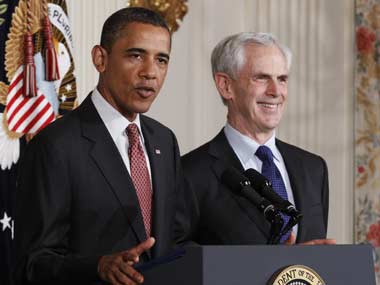President Barack Obama announced on Tuesday that he has selected a former CEO of a California-based energy company to head the US Department of Commerce.To political observers, it’s a move seemingly aimed at placating the US business community, which has becomeincreasingly disgruntled by what they view as unwieldy financial and healthcare regulations and anti-business tax policies.
Obama’s pick, John Bryson, is the former CEO of Edison International, and he currently sits on the corporate boards of Boeing and The Walt Disney Company. Bryson also co-founded the National Resources Defense Council, a legal organisation that tackles environmental causes.
[caption id=“attachment_18461” align=“alignleft” width=“380” caption=“President Barack Obama with John Bryson, whom he’s picked to be new US Commerce Secretary. Jim Young/Reuters “]  [/caption]
“I am pleased to nominate John Bryson to be our nation’s Secretary of Commerce, as he understands what it takes for America to succeed in a 21st century global economy,” President Obama said in a statement.“John will be an important part of my economic team, working with the business community, fostering growth, and helping open up new markets abroad to promote jobs and opportunities here at home.”
If he is confirmed by Congress, Bryson will replace former Washington state governor Gary Locke, a Chinese-American who has been named US Ambassador to China. (Republicans, however, say they will block the Bryson appointment until Obama commits to supporting free trade agreements with Panama, Colombia, and South Korea.)
India as part of US “jobs strategy”
The Commerce Department takes the lead on the commerce-related components of the February 2011 Economic Report of the President, which cites an explicit goal of doubling US exports by 2014. Much of this effort will be pegged to expanding trade with Asia, with a particular focus on China and India.
According to the report:
The Administration is placing increased emphasis on persuading Asian economies to reduce trade barriers and open themselves to U.S. exporters through the trans-Pacific Partnership. … My Administration has worked to knock down barriers our exporters face and advocated for U.S. exporters abroad-resulting in signing important deals to sell more American goods and services to China and India.
Accordingly, the department has repeatedly reached out to India in the past year.
In April, for example, the department coordinated its first-ever franchising trade mission to India. Fifteen US companies-including a number of fast food retailers-visited Mumbai, Hyderabad, and New Delhi to promote franchising opportunities. India’s market in this area is projected to grow to $20 billion by 2020, and US companies are currently the most prevalent among India’s foreign brands.
In February, the department also conducted a high-tech trade mission to India, which Locke has called “one of the most promising high-technology markets in the world.” During the three-day tour, 24 businesses pitched their nuclear energy, aviation, defence, and communications technology and services to Indian entities.
Both missions took place after Obama clearly signalled interest in the Indian market in November 2010, during theUS-India Business Council Summit in Mumbai.
He said strengthened relations between the US and India could be a win-win situation. He told the summit attendees that modern-day trade relations need not be “just a one-way street of American jobs and companies moving to India. It is a dynamic two-way relationship that is creating jobs, growth and higher living standards in both our countries.”
Back at home, he called his relations-building efforts in India part of his “jobs strategy,” and following the April visit to India, Nicole Y. Lamb-Hale, assistant secretary of commerce for manufacturing and services, said in a statement: “President Obama set a new mark for U.S. business in India during his visit here last November and with this mission, we are translating this new relationship into real U.S. exports and jobs.”
India is currently America’s 12th largest trading partner, with $19.2 billion in exports to India in 2010, a figure that has more than doubled between 2005 and 2010.


)
)
)
)
)
)
)
)
)



